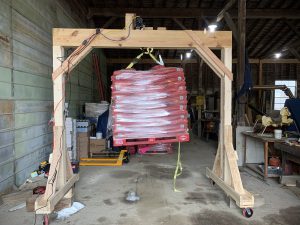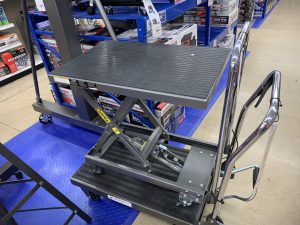Part 7 – The Financial Side
By: James Masucci
 I had thought that by this time I would be summarizing my building experience and what I learned along the way. But the floor is still waiting to be poured, meaning nothing has happened on the interior of my new honey house. That story will have to wait.
I had thought that by this time I would be summarizing my building experience and what I learned along the way. But the floor is still waiting to be poured, meaning nothing has happened on the interior of my new honey house. That story will have to wait.
I was delivering some honey to a local hardware store a couple weeks ago and they had a sign up that went something like this: “If everyone in the area spent just one dollar at a local store instead of a large box store, it would pump three million dollars into the local economy.” That sign should resonate with all of us who sell local honey. Think about it, most of us who sell to retail stores are selling to small, local stores who support local businesses, or to restaurants who pride themselves on buying from local producers. They all have access to cheap honey, but they see the value in supporting local endeavors.
My experiences over the last year, as I transitioned to a full-time beekeeper and growing my business, has given me a great deal of respect for the local businessperson. I got a flavor of the risks these businesspeople take to start and run a business. When I worked as a scientist for a large corporation, I got a paycheck whether I succeeded or failed and whether the economy was good or bad. When business drops for a local shop, the owners don’t get a paycheck, and/or they can’t pay their employees, suppliers or rent. Gosh, the pressure must be incredible. It costs a lot of money to start and maintain a business. As a hobbyist, the costs were right there in front of me: bee equipment, food, medicine, jars, labels. As I expand, I’m learning that a lot of other costs come into play.
Here are some of my take-aways regarding the financial aspect of going into the bee business. This is not a guide, or how-to. Only my experience thus far and what I am learning from it.
Initial investments
The initial investments were the most obvious costs when I decided to grow my business. I knew I needed a building for storage and a truck for efficiency. These allow me to be a larger scale beekeeper. I’ve written about this in previous Bee Culture editions. I purchased two acres of land and am in the process of putting up a 40×48 honey-house/storage facility. I got a used F450 ambulance from my son-in-law and just recently picked it up after having a flat-bed and lift gate put on it (see picture 1). I am like a kid in a candy store with my new “toys.” Those costs were significant and I have to sell a lot of honey to pay for them. I reason they are long term investments and, when I retire, I will get my money back. I was able to plan for this and there are various loan programs to which you can apply for help.

Picture 1. My new bee truck. The heavy-duty truck will allow me to do large scale beekeeping more efficiently. The lift gate on the back will minimize heavy lifting.
There were also the investments associated with expanding the size of my operation. These shouldn’t come as a surprise for a beekeeper. If you go from 100 colonies to 200 colonies, you will need the woodenware for those extra 100 colonies. You can easily plan for that too. You need to make the decision for consistent equipment (i.e. pallets or bottom boards, single or double brood boxes, deeps and/or mediums, etc) and buy or build what you need. Don’t forget about the supers, the queen excluders, the feeders, etc. Also, don’t forget the extra costs associated with hive maintenance. These include medications, food, and even the gas, since you will be driving to a lot more out yards than you are used to.
The easy to forget investments
The saying goes, “the devil’s in the details.” That’s true for the cost of starting my business, too. In my last article I described my plans for the inside of the building. I want it to have a certifiable commercial kitchen. I have my plan, then I saw the cost of the supplies. More than I expected. For example, electrical wire is around $0.50 a foot and I need around 1000 feet. 2x4s needed for framing the wall are between six and seven dollars each and I am going to need 150 of them. Then, there is the drywall, etc. Plus, the cost of three sinks, a stove, a refrigerator, a washer/dryer, toilet, shower, dishwasher, heater and air conditioner.
The above expenses are not unexpected, just more than I thought. Another area of expenses is the equipment to handle materials. Honey supers are heavy, so is sugar or sugar syrup. Then there are pallets of materials as you start buying in bulk. How do you handle all this in a way that will prevent back injuries? I broke down material handling into two categories: in the field and in the honey house. Most commercial guys have forklifts, which can do double duty. However, I can’t tow a forklift into the field because my yards are too tight for a bee truck hauling a trailer. I decided instead to have a lift gate installed on my truck. That allows me to move supers and bees using a cart in the field. I can place them on a half pallet onto my truck, then use a short-forked pallet jack to maneuver on my truck. I already have the cart. I still need to build the pallets and I need and purchase the pallet jack. I also need to purchase several rachet straps to make sure everything is tied down. Then I need something to cover the load to keep bees out of supers. Except for the lift gate, everything is under $500. But, many items at $500 adds up.

Picture 2. My home-made gantry crane and a 2400-pound pallet of sugar. This will be used to get heavy pallets off my truck and onto the floor where I can move them with a pallet jack.
There is a lot to consider for handling material inside the building. The first is how to unload my truck. For loads under 2000 pounds, I can use my lift gate. To move heavy pallets off my truck, like the 2400 pound pallet of sugar I am picking up today, I figured I need a gantry crane. The ones for sale have an inside clearance of 7.5 feet. The truck bed is eight feet, so I built one using lumber, an ATV winch, and some heavy-duty pulleys (see picture 2). It allows me to lift pallets off the bed of the truck, move the truck, put the pallet on the ground and move it with a pallet jack. Maybe not the most efficient method, but I won’t have to do this often.
The main material I will be handling is honey. Extracting aside, I need to store it, liquify it, and bottle it. The obvious question when expanding is whether the current equipment can handle the expansion. I currently extract into five gallon buckets, and I have a system where I can liquify three buckets at a time. But when I bottle, I can go through five or more buckets at a time. I need to think about storage tanks, heating units to liquify what’s in the storage tanks and mechanisms to fill the storage tanks. At 60 pounds a bucket, I want to lift those as little as possible. I am looking into getting either a U-cart or a hydraulic lift cart (see picture 3) to move the five gallon buckets from the storage area to the kitchen. Both are roughly the same cost. An automatic bottler would facilitate the bottling step, and that comes with its own expenses. The bottom line is that I must plan and execute an efficient handling system that minimizes the amount of material that I physically lift. I still need to figure out how to store the honey. Heavy-duty shelving minimizes the footprint of the honey but requires a lot more lifting without a forklift. I’m still working on that.

Picture 3. Two options for moving buckets of honey from storage to the bottling area. On the top is a U-cart. Simple, but minimizes lifting. On the bottom is a lift cart, that raises the load, so I don’t need to bend over to lift it. (The picture is of a smaller lift cart on top of a larger lift cart. They were connected in the store so I couldn’t separate them.)
 Then, there is the business side of things. There is a TV commercial for an accounting software that really hits home. I know a lot about bees, but very little about business. I’ve always done my taxes by myself. But now, I’m an S-corporation. I not only need to track sales and expenses but to classify them. I need to deal with sales tax. I need to think about commerce laws and labeling laws. Someday I may need to do payroll. I now have an accountant to help me out. I do my record-keeping on a spreadsheet but was informed by my accountant that it may be time to get that online accounting software. Not huge expenses, but they all add up.
Then, there is the business side of things. There is a TV commercial for an accounting software that really hits home. I know a lot about bees, but very little about business. I’ve always done my taxes by myself. But now, I’m an S-corporation. I not only need to track sales and expenses but to classify them. I need to deal with sales tax. I need to think about commerce laws and labeling laws. Someday I may need to do payroll. I now have an accountant to help me out. I do my record-keeping on a spreadsheet but was informed by my accountant that it may be time to get that online accounting software. Not huge expenses, but they all add up.
The continued expenses
There are a series of other costs that I really didn’t think about. These are the maintenance costs of the operation. The things you are billed for on a regular basis. Because I bought the land for the honey house, there is property tax. I had liability insurance for the company, but now I need to insure the building and the truck. I will have electricity and sewer costs associated with the building. I don’t have the final numbers, but these will likely cost several thousand dollars a year. Again, I need to sell a lot of honey to pay for these expenses. This has a large impact on my business model. Last year, I shared how I was trying to figure out how big I want to get. As I grow bigger, so do my expenses. Where before, I didn’t have property tax, and bee truck insurance and maintenance costs; now I do. I may have forced myself to grow bigger just to cover these additional expenses.
For everyone out there thinking about growing their beekeeping operation, think about this. It can be done. But for every action you take, there is a reaction. Think hard about how much your expansion will cost. Both the obvious and the non-obvious expenses. Then, determine if you have the passion for and the belief in your success to make those investments. That’s what’s needed to create a successful business. That’s why I have developed such a deep respect for our local businesspeople. That’s why you should buy local…
Click here to go directly to Part 6 – Getting Ready to Build








